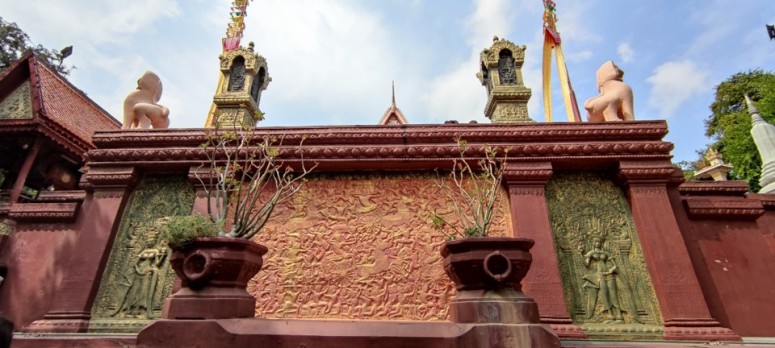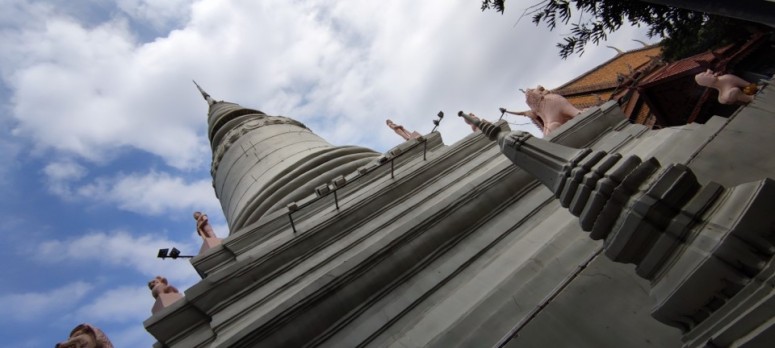One of the most interesting practices that takes place in the Wat Phnom is the release of life (放生) in this case birds. Releasing a life, especially during a new year is seen as a way to accumulating good karma to start the year. We noticed people would pay for a bird or two, have them in their hands with the birds not struggling and release them after a quick selfie.
(No good deed can go without a photo, thats a basic expectation these days)
But watch a little longer and something interesting happens, barely 30 minutes after the hawker sells all their birds they are back with a new cage full of birds, as if there was an endless supply of sparrows.
“Look at how comfortable those birds are in their hands, these birds are very used to being handled by humans… These are mostly likely pets or owned by the seller themselves.”

Welcome to the drama of Wat Phnom.

A syncretic temple, it was completed in 1373 on the orders of a wealthy lady Penh who received divine inspiration to construct a temple.

According to legend, “one day, when it was raining, Penh went down to the port to take a bath and saw a floating Koki tree in the river and she called the village to fish it from the water. She and the villagers took a piece of wood to scrape off the mud and in the hole of the Koki tree, there were four Buddha statues made of bronze, brass and one made of marble. Another statue was in the form of Vishnu with the hands holding a staff, a chain, a snail, and a lotus flower. Penh asked the villagers to help retrieve the Koki tree and retrieve the four treasures. Later, Penh assigned the villagers to build an artificial hill and build a small wooden temple on top of the hill to house the statue. She invited monks to pray for the statues and the monks named the hermitage ‘Wat Phnom’ which is known to this day.”

Not unlike the Church of the Holy Sepulchre in Jerusalem, reglious places of significance are massive in the mind even if they are small in structure, that was my experience of Wat Phnom. The centre piece of Wat Phnom is the inner sanctuary of a golden Buddha. The Buddha is surrounded by a collection of dieties at the side and a non stop litany of Buddhist chanting.
Khmer Buddhism is the state religion of Cambodia today, and has been so since the 13th century, in its prior history it was Hindu and was ruled by a long line of Hindu kings (across the Funan, Chenla and Angkor empires).
Thevadara Buddhism emerged at the end of the Angkor period when the prince was sent to learn Buddhism in Sri Lanka. The Prince, Tamalinda, was inspired by the emerging form of Thevadara Buddhism which was differentiated by its theological differences to Tamil Hinduism. Tamalinda returned to Cambodia after 10 years after and returned as a senior monk with the ability to ordian and teach. His return coincided with the gradual mass conversion of the Khmer people to Buddhism – and event that historians still cannot fully explain.

The rise of Buddhism saw the ancient capital of Angkor (near today’s Siem Reap) recede into the forest and the social, religious and political centre move further south towards Phnom Penh where Lady Penh established the Wat Phnom practicing Thevadara Buddhism as influenced by Sri Lanka. This line of Buddhism would go on to however cause alot of strain between the cambodian nation and its neighbours in paricular Vietnam where the majority practiced the Mahayana tradition of Buddhism instead. The countless battles between the Vietnamese conquered Cambodians from the 14th to 16th centuries were shaped by the difference in type of Buddhism practice.

Thevadaran buddhism had by now rooted itself as a core part of Khmer identity, and despite the arms and weapons of the French Catholicism never took root – in fact the French had to violently put down various armed insurrections led by Buddhist Holy men during their colonial rule over Cambodia. Depsite literally killing thousands of monks, the Khmer Rouge was also not able to remove Buddhism from the people’s hearts and is today a indivisible part of the Cambodia national identity.
Arguabley as fascinating as the story of buddhism in Cambodia is the small little temple to a Chinese diety next to the main altar – Guan Yu. If the main inner altar was busy, the small temple was packed – a story about the Chinese in Cambodia to be unpacked at another time…
ON THE MAP
